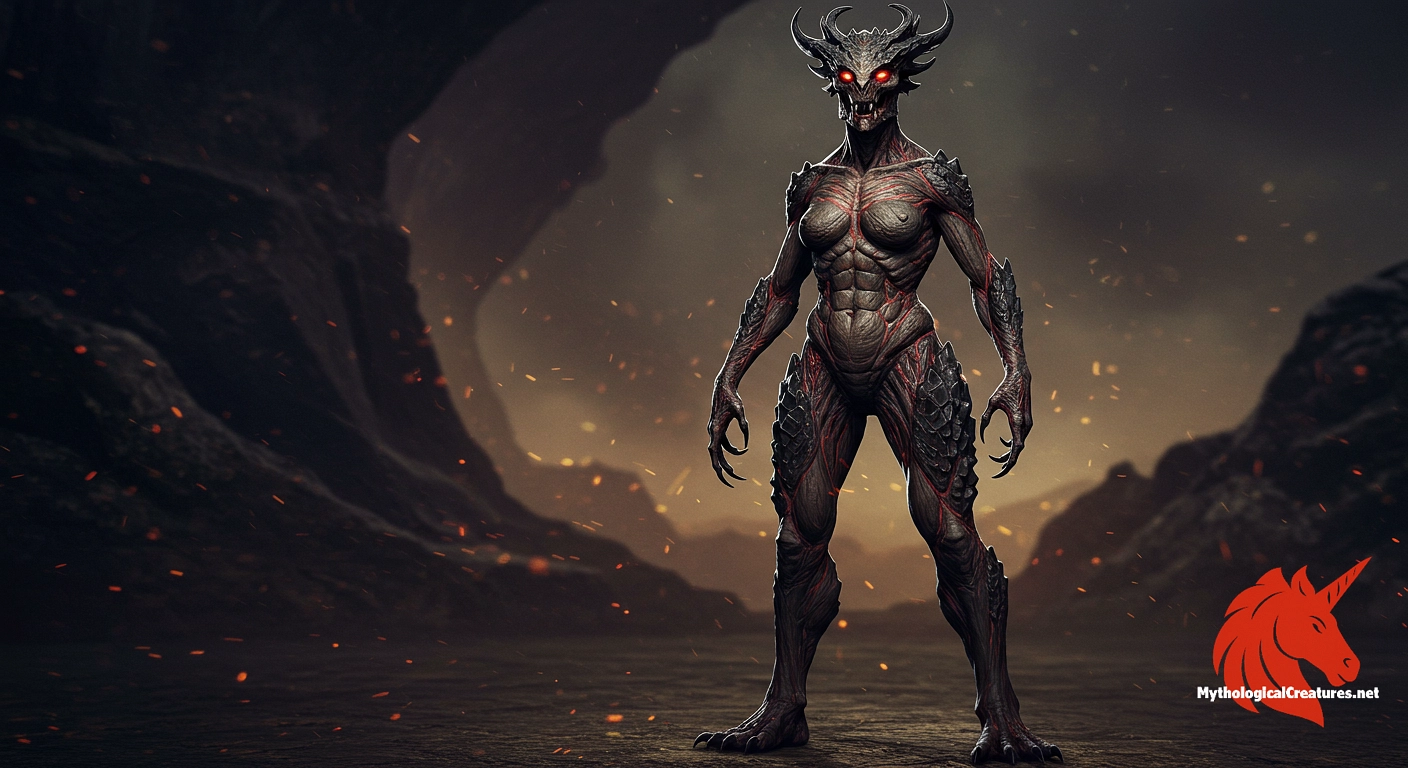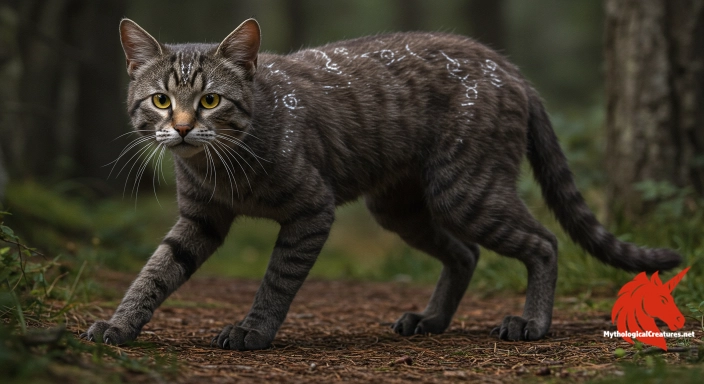Campe: Campe is a monstrous female figure in Greek mythology known for guarding the imprisoned Cyclopes and Hecatoncheires in Tartarus.

Campe
Campe - Campe's death by Zeus was pivotal in freeing the Cyclopes and Hecatoncheires, thereby influencing the outcome of the Titanomachy.
Origins & First Encounters
Campe emerges from the ancient tapestry of Greek mythology as a formidable female guardian residing in the dark recesses of Tartarus. Her origin is shrouded in early mythic tradition, where she is tasked with overseeing the imprisonment of the Cyclopes and Hecatoncheires. This role, though scarcely elaborated in surviving texts, marks her as a pivotal figure in the cosmic order during tumultuous times. The narrative of Campe is intertwined with the epic struggles of the Titanomachy, a war that set the stage for the rise of the Olympian deities. In a period defined by celestial upheaval, her duty symbolised the delicate balance between chaos and order. Her appearance in myth serves as a reminder that even monstrous beings had a place within the divine hierarchy. The scant details of her early attestation hint at a ritualistic quality, emblematic of the ancient Greek approach to embodying cosmic power. As a minor yet significant figure, Campe encapsulates the inevitability of change, where the forces of old are overcome by new divine order. Her myth endures as a testament to the intricate mechanisms of fate and retribution within the ancient world.
Source Texts & Tale Variants
Ancient records, though limited, offer a glimpse into the story of Campe as recorded by mythographers such as Apollodorus. Her tale is primarily recounted in the context of cosmic battles, where she appears as a guardian whose downfall is instrumental in the liberation of powerful beings. Several sources maintain that her demise was an essential step in empowering Zeus with crucial allies during the war against the Titans. Variations in the myth reveal that oral traditions sometimes expanded her narrative, lending her additional layers of symbolism. Some later Hellenistic texts elaborated on her role, suggesting an even more complex character than the brief references of earlier traditions imply. While some accounts stress her terrifying aspect, others hint at a duty-bound inevitability behind her grim assignment. This fluidity in her characterisation illustrates the mutable nature of myth as it was passed down through centuries. The evolution of her portrayal reflects differing regional narratives and the adaptation of myth to serve the moral and cosmological themes of the times. Such discrepancies highlight how Campe’s story was dynamically interwoven with the broader fabric of Greek myth, allowing later generations to reinterpret her significance.
Form & Powers
Although ancient texts offer few explicit details about her appearance, later mythological interpretations have painted a vivid portrait of Campe as a daunting figure. She is imagined as a colossal being whose body carries the raw, untamed energy of the underworld. Some artistic reconstructions blend elements of both human and beast, creating an image that is at once alluring and repulsive. Her eyes are often described as glowing with a fierce, infernal light, echoing the eternal fires of Tartarus. Shrouded in wild, unkempt hair and rugged features, her countenance exudes a sense of eternal wrath and sorrow. Additional embellishments in later retellings have introduced serpentine textures or scaled skin, emphasising her connection to primordial chaos. The powerful limbs and clawed hands attributed to her underscore her role as both a guardian and an executioner. Despite the scarcity of contemporary descriptions, these later artistic visions have crafted a composite image that is both mysterious and formidable. Her form, ever-changing in retellings, symbolises the union of beauty and horror inherent in the monstrous figures of mythology. Through these imaginative depictions, Campe has come to represent the tangible face of ancient cosmic unrest.
Regional Faces
The myth of Campe did not remain static but was adapted by various locales to suit regional artistic and cultural narratives. In certain parts of ancient Greece, particularly in areas with a deep connection to underworld lore, her image absorbed local attributes such as serpentine motifs and exaggerated beastly features. In the Hellenistic world, where myth was often reinterpreted to reflect philosophical ideas, Campe was sometimes portrayed with a more human-like aspect, softening the terror of her form to symbolise a guardian caught between duty and despair. Southern Italian and Eastern Mediterranean traditions, influenced by a blend of Greek and local myth, introduced modifications that highlighted her role as an intermediary figure between order and chaos. These regional variations transformed her from a mere monstrous jailer into a more nuanced emblem of cosmic limitation and inevitable transformation. Variations in artistic depictions further illustrate how different communities viewed the balance between divine retribution and mercy. Local narratives sometimes recast her as a warning against hubris and as a symbol of the destructive potential of unchecked power. The regional adaptations of her story reveal how myth can be moulded by local tastes and values, ensuring its continued relevance through changing cultural contexts.
Cultural Parallels
In the panorama of world mythology, Campe finds parallels with other guardians who stand at the thresholds of tumult and order. Her role as a monstrous warden is reminiscent of figures like Cerberus, though her function is uniquely tied to the liberation of imprisoned beings. Comparable archetypes appear in a range of cultural traditions, where sentinels guard the passage between realms, such as the fierce beings in Norse and Celtic mythologies. This motif, common to many traditions, underscores the human preoccupation with delineating sacred boundaries and controlling the forces of chaos. Like other mythic guardians, Campe represents the inevitable clash between dark, primordial energies and the emerging order heralded by divine intervention. In various legends, the defeat of such creatures often marks a turning point that signals the restoration of balance and the ushering in of a new era. Her narrative intersects with those of similar beings who, despite their terror, serve a necessary function in the cosmic cycle. The recurring theme of a monstrous custodian whose fall enables transformation is a testament to the universality of such mythic symbols. Comparative analysis across cultures reveals that while the specific details may vary, the archetype of the guardian remains a powerful and enduring element in myth-making.
Legacy & Modern Evolution
Over the centuries, the enigmatic figure of Campe has undergone a remarkable evolution from a scarcely mentioned myth to a subject of modern reinterpretation. In classical antiquity, her role was confined to the backdrop of epic cosmic struggle, yet later periods began to unveil her latent symbolic complexity. The Medieval and Renaissance eras, in particular, saw a revival of classical themes, allowing Campe to emerge as a symbol of the darker aspects of divine retribution and the inevitable cycle of chaos and order. In contemporary fantasy literature and art, she is frequently reimagined as a multifaceted guardian whose tragic fate underscores the tension between power and duty. Modern reinterpretations often imbue her with a sense of pathos, highlighting the dual nature of her existence as both a monster and a reluctant enforcer of cosmic balance. Digital media and graphic novels have further expanded her legacy, transforming her image into a dynamic blend of historical myth and modern symbolism. Scholars today revisit her story to explore themes of transformation, resistance, and the redefinition of monstrousness in the context of modern cultural narratives. The reemergence of Campe in popular culture serves as a testament to the enduring appeal of ancient myths, offering fresh perspectives on timeless questions about order, chaos, and the human condition. Even as her ancient origins remain firmly rooted in the past, her evolving legacy continues to inspire contemporary reinterpretation and creative expression.
Interesting Fact
Despite her fearsome role, Campe's story is a reminder of how even monstrous guardians can be pivotal in the grand narrative of divine conflict in Greek mythology.
Quick Creature Info
Origin:
Features:
Associations:
Our Mythic Legendary Rating:

Also Sometimes Known As:
Habitat:
Supernatural Powers:
Physical Attributes:
Abilities:
Behavior:
Weaknesses:
Lore:
References
Discover Another Mythical Legend You May Not Have Heard Of?
Uncover the mysteries of ancient folklore and expand your knowledge of legendary beings from cultures around the world.
Dare to Meet the Troll cat....
Mythical Disclaimer: The images and data on this site are derived from various historical and literary sources, but we have found that many myths often have multiple versions and interpretations across references, sometimes contradictory. As a result, these creature depictions are artistic interpretations—imaginative blends of folklore, legend, and a dash of AI guesswork. Because creature descriptions vary widely, our illustrations and accompanying information represent our best effort to honor mythology while bridging creative gaps. Enjoy these interpretations—just remember, we've done our best to respect the stories and validate available data, but in the realm of mythology, details often shift, imagination leads the way, and nothing is ever set in stone!
Curated by the Mythological Creatures Team (rev. May 2025)
